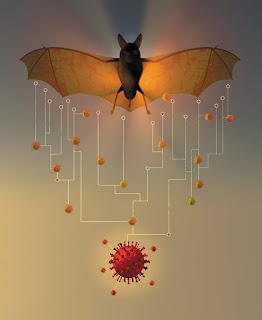With every country in the world now in its second year of the pandemic, the desire to find out exactly how this nightmare started is intense. Last month, Jonathan Perker and others published a scientific report “Timing the SARS-CoV-2 index case in Hubei province” which offers several interesting points.
*****
Tracing the history of the virus to the start is akin
to detective work. Through a virus DNA analysis, it is possible to keep going
back on the evolutionary tree. If any places have stored wastewater samples
from 2019, they can be analysed to check the presence of the virus. This team
of researchers focused on three important pieces of information. (a) How the
virus spread in Wuhan before the lockdown. (b) The genetic diversity of the
virus in China and (c) Reports of the earliest cases in China.
Their models also ran retrospective epidemic
simulations to learn the timing and the scale of the spread.
*****
The first documented case was on 17 November 2019. The
analysis puts the index case in Hubei around 4 November. Retrospective mapping
indicates that the earliest case could have happened in mid-October, not
before.
The interesting finding of the study is that the virus
didn’t originate in the Wuhan seafood market. Because several cases from early
December lacked genetic connections to the clusters in the market.
The data and the epidemic simulations show that 70% of
the cases with this virus were self-limiting. In other words, the infected
person recovered without passing the infection on. Epidemics that go extinct
typically produce a single infection, never more than 44 infections, and never
more than 14 infections at one time. It seems there is no such thing as a “pandemic
virus”; the same coronavirus had infected dozens of Chinese people. In 70% of
the cases, the virus was not transmitted further.
*****
To become an epidemic, a virus requires a host, and a
superspreader setting. One of the infected people went to the Wuhan seafood
market, which offered the virus the lucky break. A crowded, wet, unhygienic
market was an ideal setting for the virus to start spreading.
It’s like a smoker throwing a burning cigarette on the
road. It rarely causes an incident. But if the same burning stub were to be
thrown in a dry forest, it can set the entire forest on fire.
If that infected person, (and scientists haven’t
managed to identify him or her), had not gone to the Wuhan market that day, or simply
watched TV at home, or hated seafood, or was too ill to leave home, the pandemic
may not have happened. The seafood market was not the origin of the virus, it
was a spreader.
*****
Scientists the world over are aware of the pandemic
potential of viruses. The common surveillance methods, though, keep an eye on hospitalizations
and deaths. In SARS (2003), every tenth infected person died. The action was
more immediate. MERS (2012) had a case fatality ratio of nearly 35%. The high
death rates could have contributed to stopping the earlier coronavirus
pandemics quickly.
Covid-19 is not as deadly. Ironically, that was
tragic. Had the covid virus started killing 10% or 35% of the infected, it
would have been spotted more quickly. Before the Chinese scientists found
enough covid patients in hospitals or morgues, its spread had become
unstoppable.
*****
The study finds that the virus existed initially only
in China. The same model of an infected person and a superspreader setting may
have played across the world. The virus was introduced several times everywhere
(for example, Chinese workers returning to Italy after the Chinese New Year)
but it took some superspreader setting for it to spread. Cases were found in
France (December 2019) and California (January 2020), but it took many weeks
after that for the outbreaks.
*****
The lesson from the study: If you are infected with an
unknown virus, please don’t visit a packed, crowded place. It is as bad as
throwing a burning matchstick in a forest.
Ravi

आज 3 लाख भाविकांनी शाही स्नान केले. जय हो
ReplyDeleteAgain fascinating
ReplyDelete